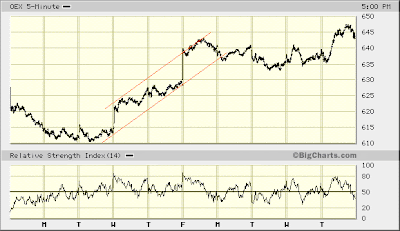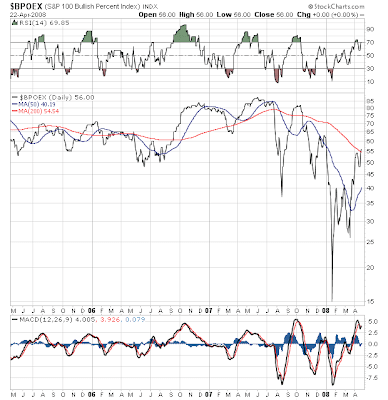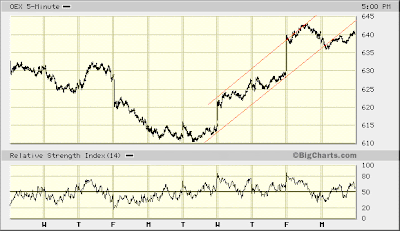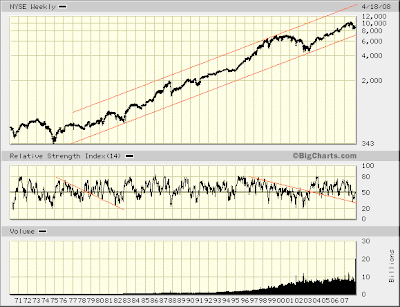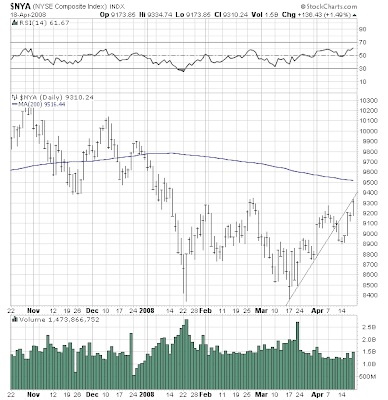Just like yesterday, everything went as we would want. A narrowly confined advance, much as unfolded early-October '07, appears straight ahead (at least in some similar form). There should come several "Aha!" technical divergences as the stock market rises to its top from here. At least that's the plan.

At this point I should think we might see a break from the price-RSI pattern's similarity to last October '07, though. Now would be a good time for the several "Aha!" technical divergences I'm expecting to begin taking form.
Looking at the arbitrary lines drawn on the above S&P 100 chart, the top line has had several touches, and appears a barrier of sorts. A move to the bottom line could be in store. This [probably] would demonstrate a certain break down of buying support. Then following ... as the S&P 100 makes a final charge higher (to the top line) ... should come the kind of technical divergences typically coinciding with a stock market that is about to accelerate lower.
And that is when the game will begin.
By the way... This is a game a lot like "Deal or No Deal." Its playing impacts your psychology toward making money ... as your prospects build for making even more.
This is one reason why I choose to limit my stock index options speculations exclusively to points in time (like now) when I, an Elliott Wave Guy, am relatively certain about both the stock market's direction and the power behind its likely move.
You've heard the saying, "Time is money?"
You would be hard-pressed to find anything outside of the options game where this saying has more meaning. With options timing is everything. So, the faster the move the better. And a declining stock market is best of all. Fear simply is a powerful emotion. Its demonstration becomes pronounced when the market threatens loss.
Given this, then, that is why I pick my spots, and why I limit my risk to such a pittance ($500).
I strongly advise you do the same. Bulls make money, bears make money, and pigs get slaughtered. When you see how quickly $500 can be multiplied into a small fortune, you might better understand how easy it is to become a pig. Don't do it. You will give it all back. Wait for opportunities like the one coming ... whose probability I have stated (for the record) is 70%.
Play only then. You see with your own eyes how short-term analysis I bring has needed to be flexible. That's just the nature of the game. Simply put, most of the time you cannot call the stock market's every zig and zag. But sometimes (and only sometimes) you can. The best of times generally arrive in big moves you recognize a million mile away...
Okay...

Imagine yourself a big-shot market player. The Fed show is over. Uncertainty apparently still reigns. This afternoon's break came with some unexpected strength ... following a price-RSI divergence at today's top ... and this late-day sell-side strength was not erased in the last hour of trading. So, are you more likely to jump in with both feet, or will you only, at most, stick in your toe?
Think of this with the past eight days in mind — a rather tortured move higher, suddenly and strongly turned over today.
Thus, I suspect pressure could develop here stalling any immediate prospect for a move higher (particularly any advance that might defy my near-term outlook forecasting the stock market is quite near a hard turn lower).
Of course, this is just an intelligent guess no different than any others I have made these past two months. Yes, there's been some regularity of correctness. No, I'm not Tony Nelson and I haven't found a genie.
For all you Elliott Wave doubters out there ... the proof is in the pudding.
With that in mind, then, what else can I say?
Patience pays mad money when it's like playing "Deal or No Deal" with x-ray vision into the briefcase containing $1,000,000.
Superman says stay tuned.
* * * * *
© The Risk Averse Alert — Advocating a patient, disciplined approach to stock market investing. Overriding objective is limiting financial risk. Minimizing investment capital loss is a priority.
Analysis centers on the stock market's path of least resistance. Long-term, this drives a simple strategy for safely investing a 401(k) for maximum profit. Intermediate-term, investing with stock index tracking-ETFs (both their long and short varieties) is advanced. Short-term, stock index options occasionally offer extraordinary profit opportunities when the stock market is moving along its projected path.
Nothing is set in stone. Nor is the stock market's path of least resistance always known. More often than not, there are no stock index option positions recommended.
 There's an easy way to boost your investment discipline...
There's an easy way to boost your investment discipline...Get Real-Time Trade Notification!








